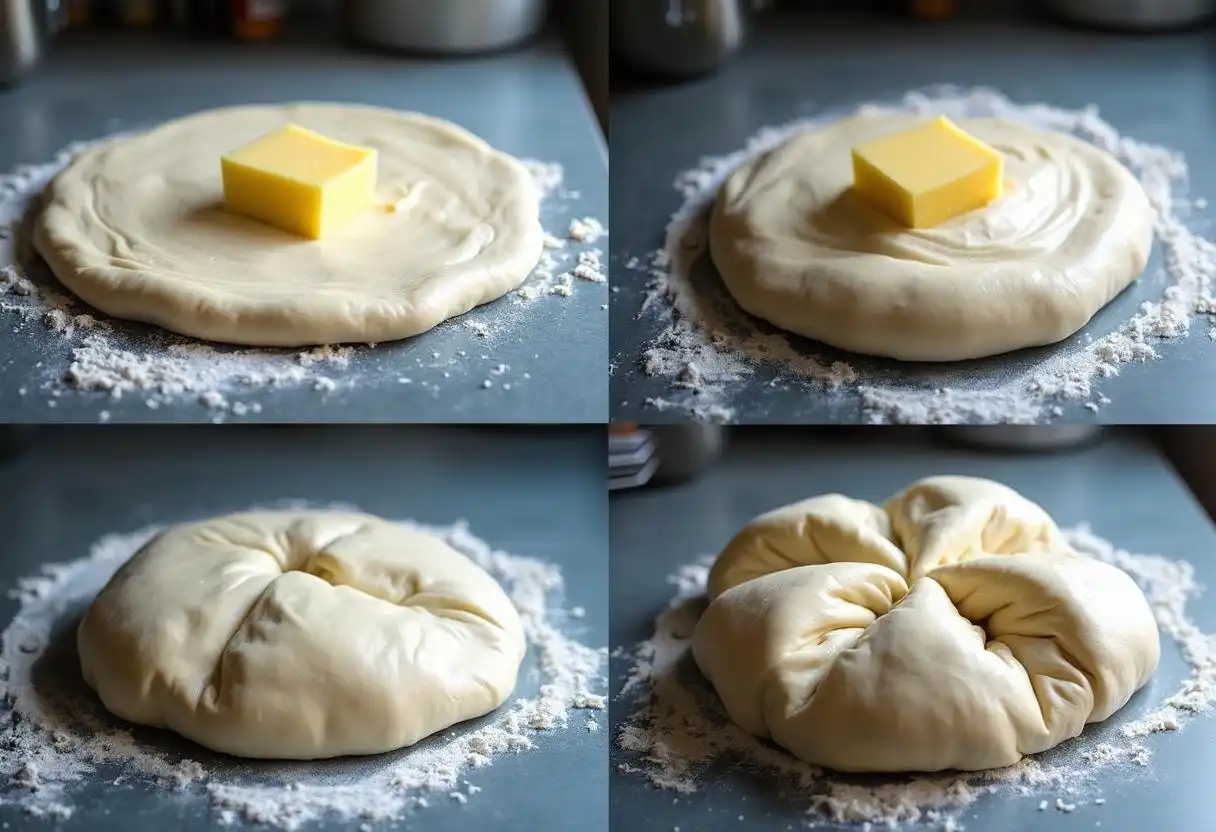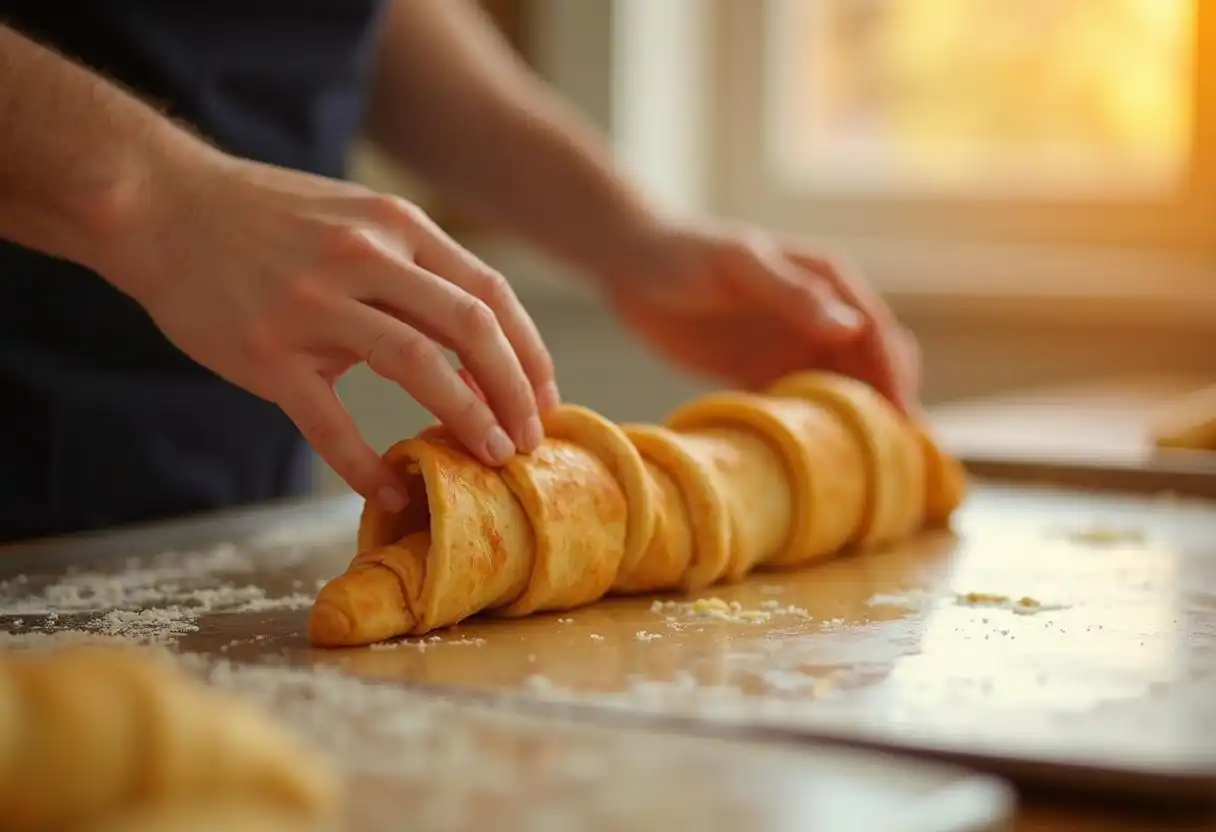Alright, fellow pastry enthusiasts, pull up a chair, grab a coffee! Let’s talk croissants. Mamma mia, is there anything better than a truly perfect croissant? That first bite, the shatter of flaky layers giving way to that soft, buttery inside… it’s pure magic, right? My kids go absolutely nuts for them, and even my goofy husband knows a good one when he tastes it. But what exactly IS the secret? What separates a meh croissant from a masterpiece? It’s not just throwing some flour and butter together, let me tell you. It’s part art, part science, and a whole lotta patience. So, let’s go on a little adventure together and uncover what is the secret to a good croissant. We’ll break down everything from ingredients to technique, so maybe, just maybe, you’ll feel ready to tackle these beauties yourself!
Why Croissants Matter
Okay, maybe “matter” sounds dramatic, but croissants are special! They’re more than just breakfast pastry. They’re a benchmark of baking skill, a little piece of edible luxury you can find anywhere from your corner bakery to a fancy Parisian pâtisserie. They manage to be both simple (just a few ingredients!) and incredibly complex to make well. Moreover, a truly good croissant, golden and puffed-up, is just beautiful to look at, isn’t it? It promises flaky, buttery happiness.
The Art Behind a Good Croissant
Making an exceptional croissant? Honey, it takes work! It’s this delicate balance of precise measurements, patience that would test a saint, and honestly, a good dose of love for the process. Nonna always said the best food needs care, and croissants demand it! You gotta understand how the ingredients work together, how temperature changes things, how gentle you need to be. Indeed, it’s definitely an art form, but don’t worry, we’re going to demystify it together!
Ingredients for Success
First things first: what goes into these flaky wonders? Like any good recipe, it starts with the foundation – the ingredients. Choosing wisely here is half the battle, folks!
Essential Ingredients
No crazy stuff needed, just quality basics. You’ll typically need:
- Flour: Usually a bread flour or a mix, providing the structure and chew.
- Butter: The star! Creates those flaky layers and gives that rich, dreamy flavour. More on this superstar in a sec.
- Milk/Water: Liquid for hydration, contributing to texture. Often a mix.
- Yeast: Makes the dough rise, giving that lovely airy interior.
- Salt: Crucial for flavour! Don’t skip it; it balances the richness.
- Sugar: Just a touch, mainly to feed the yeast and add a hint of balance.
Choosing High-Quality Butter
Okay, let’s talk butter, because it’s everything in a croissant. Quality is non-negotiable here! Many bakers swear by European-style butters because they generally have a higher fat content (usually 82% or more) and less water than standard American butter. That higher fat percentage means more flavour and helps create distinct, separate layers during lamination. It also tends to be more pliable when cold, which is key for rolling. Therefore, splurging on good butter is a huge part of what is the secret to a good croissant. If you’re curious about the whole butter vs. margarine debate in baking, well, for croissants, it’s gotta be butter, amici!
Preparation Techniques
Now, let’s roll up our sleeves (literally!). The techniques used are just as vital as the ingredients. This is where the real craft comes in.
The Role of Precision in Baking
Baking, especially pastry, is like chemistry class, but tastier! Precision is absolutely key. You need accurate measurements (a kitchen scale is your best friend here!) and consistent techniques. Just winging it? Mamma mia, not with croissants! Even tiny changes can throw off the whole balance. Thus, paying close attention to the recipe details is super important.
Importance of Temperature Control
Temperature is HUGE in croissant making. HUGE! You need to keep things cool – the dough, the butter, even your kitchen if possible! If the butter gets too warm and melts into the dough instead of staying in distinct layers, kiss that flakiness goodbye. Cold dough is easier to work with, and cold butter creates steam in the hot oven, which puffs up those layers. Moreover, understanding how temperature affects everything is critical. Think of it like keeping ingredients chilled for perfect puff pastry – same principle, different delicious outcome!
Laminating the Dough
Alright, the heart of the matter: lamination! This is where the magic layers are born.
What is Laminating?
Fancy word, simple concept (in theory!). Lamination is just the process of creating super-thin alternating layers of dough and butter. You basically encase a slab of cold butter within your dough, then roll it out, fold it over on itself (like folding a business letter), chill it, and repeat the rolling and folding process several times. Basically, you’re building a delicate, buttery skyscraper inside your dough!
Butter Layering Tips
So, how many layers of butter should a croissant have? It depends on the number of folds! Each “turn” or “fold” multiplies the layers. Most recipes call for 3 or 4 “turns,” which creates hundreds of paper-thin layers. Too few layers, and it won’t be flaky enough. Too many, and the layers can get squished and become tough. It’s a balance! Most recipes aim for that sweet spot giving you clear separation and maximum puff.
Achieving Consistency
Getting those layers even is the tricky part. You need to roll the dough to a consistent thickness each time without squishing the butter out or tearing the dough. Keep that butter cold but pliable! Hence, patience and practice are your best friends here. Don’t get discouraged if your first attempt isn’t perfect – mine certainly wasn’t!
Shaping the Croissants
Your beautiful laminated dough is ready! Now comes the fun part – shaping those iconic crescents (or sometimes straight sticks!).
Proper Shaping Methods
Whether you go for the classic curve or a straight shape, the basic idea is the same. You cut the dough into long triangles. Then, starting from the wide base, you gently but snugly roll the triangle up towards the point. The method is simple, but requires a light touch. For the crescent, you just gently curve the ends towards each other after rolling.
Avoiding Overworking the Dough
Handle with care! As you shape, try not to squish or stretch the dough too much. It’s important to preserve those precious layers you worked so hard to create. Overworking can make the final croissant dense instead of light and airy. Instead, think gentle persuasion, not brute force!
Fermentation and Proofing
We’re almost there! This next step – letting the shaped croissants rise (proof) – is crucial for texture and flavour development.
Importance of Proper Proofing
Proofing is where the yeast does its final job, creating carbon dioxide gas that inflates the dough, making the croissant light, airy, and tender inside. If you skip or rush this, you’ll get dense, sad croissants. Proper proofing is absolutely essential for that delicate honeycomb structure inside. Indeed, this stage develops both texture and flavour.
Timing it Right
Knowing when they’re perfectly proofed takes a bit of practice. You want them to look noticeably puffy, almost doubled in size, and feel soft and delicate, maybe even a little jiggly if you gently nudge the pan. Under-proofed means they won’t rise well in the oven. Over-proofed, and they might collapse or lose their shape. Therefore, keep an eye on them! Warmer kitchens mean faster proofing.
Baking for Perfection
Mamma mia, the final act! Time to transform that delicate dough into golden, flaky perfection.
Ideal Oven Settings
A hot oven is key! You generally want to bake croissants at a relatively high temperature, around 375-400°F (190-200°C), at least initially. This heat quickly turns the water in the butter layers into steam, creating that explosive puff and lift. Some recipes then reduce the temperature slightly to ensure they bake through evenly. Also, make sure your oven is fully preheated!
Ensuring the Perfect Finish
Want that beautiful, deep golden-brown, shiny finish? An egg wash (egg beaten with a splash of milk or water) brushed on before baking is the secret! Bake until they’re gloriously golden and puffed. They should feel light when you (carefully!) pick one up. In the end, that perfect color and delicate crispness tell you they’re done.
Common Mistakes to Avoid
Hey, we all make mistakes! Especially with something tricky like croissants. Knowing the common pitfalls can help you steer clear.
Over-Proofing and Under-Proofing
Yep, this one’s a biggie. As we said, proofing is crucial. Too long (over-proofed), and they can collapse or taste yeasty. Too short (under-proofed), and they’ll be dense bricks. Watch for that puffy, jiggly stage!
Incorrect Butter Placement
Butter leaking out in the oven? So frustrating! This often happens if the butter layer wasn’t sealed in properly, if it was uneven, or if it got too warm during lamination or proofing. Thus, keeping that butter nicely chilled and evenly distributed is key.
Overworking the Dough
Being too rough or mixing/kneading the dough too much develops the gluten too strongly, making the croissant tough instead of tender and flaky. Therefore, remember: gentle hands, especially during lamination and shaping! If you’re keen to learn more, I’ve got a whole post dedicated to common mistakes when making croissants and how to fix them.
Improving the Flavor
Think a plain croissant is perfect? It is! But sometimes you wanna jazz things up, right?
Adding Subtle Enhancements
So, how to make a croissant taste better? Use the best quality butter you can find – that’s number one! A long, slow, cold fermentation of the initial dough (before lamination) can also develop deeper flavour. Or, get creative with fillings! A strip of good dark chocolate for pain au chocolat, or some almond cream (frangipane) for an almond croissant – Mamma mia, delicious!
Serving Freshly Baked Croissants
There is absolutely nothing better than a croissant warm from the oven. Nothing! Serve them as soon as they’re cool enough to handle for the ultimate experience. That crispness, that aroma… sublime! Perfect plain, with coffee, or maybe with a tiny bit of jam. In short, freshness is truly key!
FAQs
Alright, let’s tackle some frequently asked questions about getting that croissant perfection!
Q: What makes the perfect croissant?
Q: How many layers of butter should a croissant have?
Q: How to make a croissant taste better?
Q: What is a mistake when making croissants?
Conclusion
And there you have it, my baking buddies! We’ve journeyed deep into the heart of croissant creation, exploring everything from the best butter to the magic of lamination and the patience of proofing. We’ve uncovered what is the secret to a good croissant – it’s a mix of quality ingredients, precise technique, temperature control, and yes, a whole lot of love!
Making croissants might seem intimidating, I get it! But Nonna always said, “You don’t know until you try!” Don’t be scared. See it as a fun challenge, a weekend project. Your first batch might not be Parisian bakery perfect (mine sure weren’t!), but you’ll learn SO much. And even imperfect homemade croissants, warm from your oven, are pretty darn amazing. My kids devour even the slightly wonky ones! Plus, you’ll gain major bragging rights. If you’re curious about croissant cousins, you might also wonder what the difference is between a croissant and a Gipfeli.
Ultimately, the real secret is the passion you bring to your kitchen. So go ahead, give it a whirl! Enjoy the process, embrace the buttery mess, and savor the incredible results. There’s nothing quite like sharing warm, flaky croissants made with your own two hands.
I’d LOVE to hear about your croissant adventures! Did you try it? Any funny stories or aha! moments? Share your experiences or ask more questions in the comments below. Let’s keep the flaky fun going! Happy baking, amici!




Leave a Reply